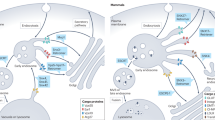Abstract:
The trans-Golgi network (TGN) is a major secretory pathway sorting station that directs newly synthesized proteins to different subcellular destinations. The TGN also receives extracellular materials and recycled molecules from endocytic compartments. In this review, we summarize recent progress on understanding TGN structure and the dynamics of trafficking to and from this compartment. Protein sorting into different transport vesicles requires specific interactions between sorting motifs on the cargo molecules and vesicle coat components that recognize these motifs. Current understanding of the various targeting signals and vesicle coat components that are involved in TGN sorting are discussed, as well as the molecules that participate in retrieval to this compartment in both yeast and mammalian cells. Besides proteins, lipids and lipid-modifying enzymes also participate actively in the formation of secretory vesicles. The possible mechanisms of action of these lipid hydrolases and lipid kinases are discussed. Finally, we summarize the fundamentally different apical and basolateral cell surface delivery mechanisms and the current facts and hypotheses on protein sorting from the TGN into the regulated secretory pathway in neuroendocrine cells.
Similar content being viewed by others
Author information
Authors and Affiliations
Additional information
Received 2 November 2000; received after revision 19 February 2001; accepted 19 February 2001
Rights and permissions
About this article
Cite this article
Gu, F., Crump, C. & Thomas, G. Trans-Golgi network sorting. CMLS, Cell. Mol. Life Sci. 58, 1067–1084 (2001). https://doi.org/10.1007/PL00000922
Issue Date:
DOI: https://doi.org/10.1007/PL00000922



